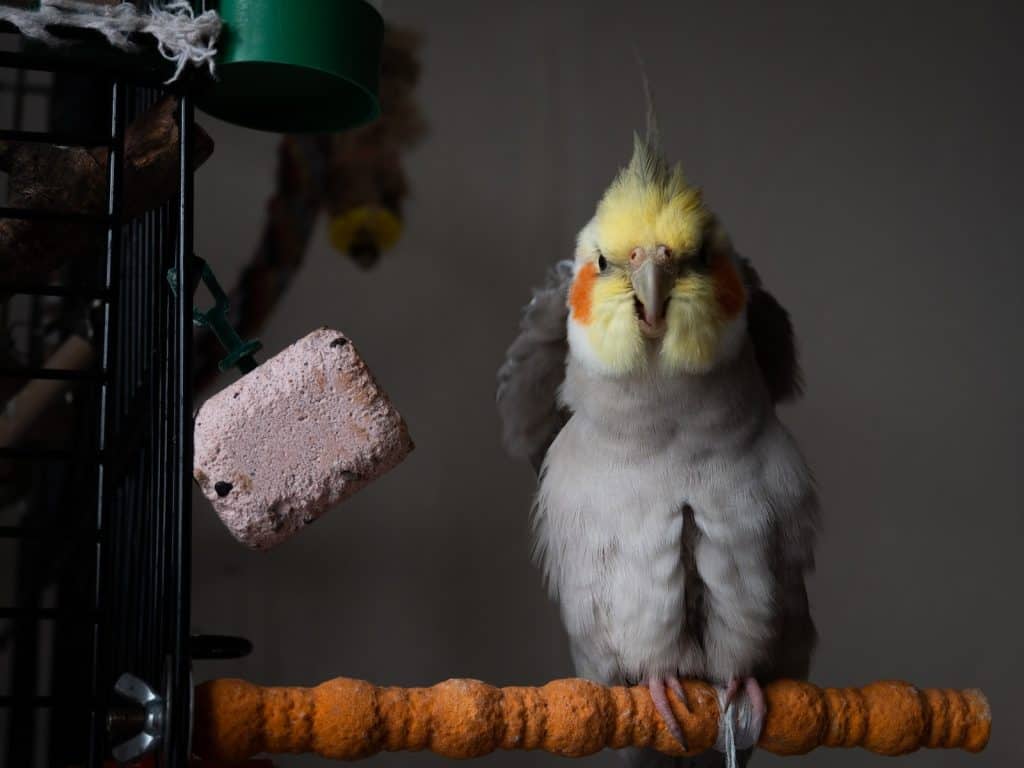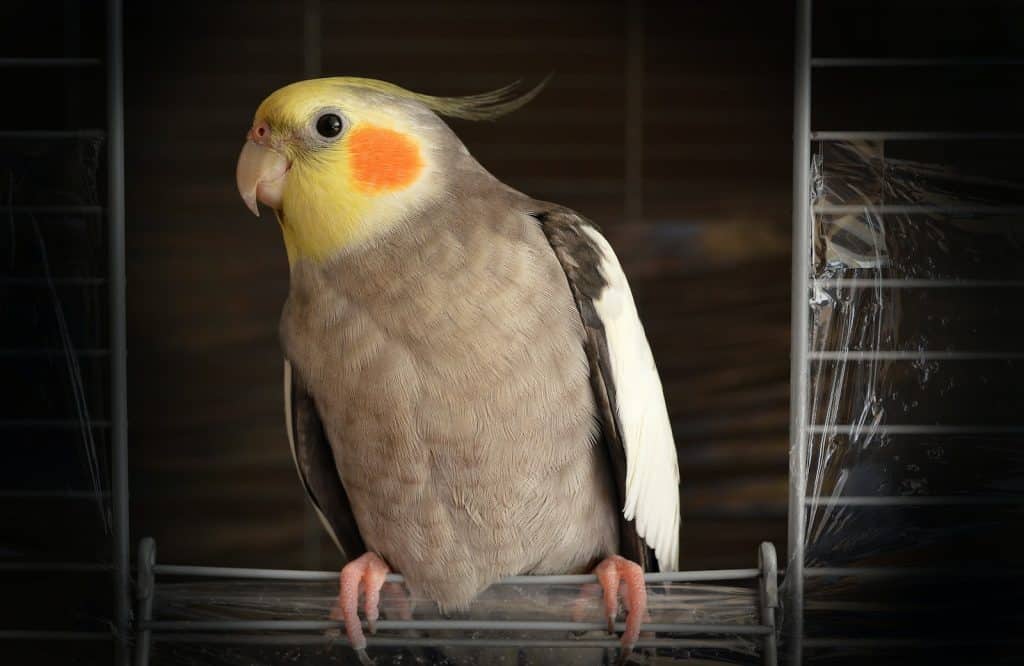Many people believe that all animals enjoy being cuddled, but this simply isn’t true. For example, cockatiels don’t always want to be held close. So the question is, can you still bond with your cockatiel without cuddling? Let’s explore!
Do Cockatiels Like to Cuddle?
Do Cockatiels Like to Cuddle? Are Cockatiels Soft and Sweet? Cockatiels can, in fact, be cuddly, but it depends on their personality and trust in you. Cockatiels are sociable, joyful, and loving animals that enjoy human contact at heart.
Cockatiels like human interaction, to have their head and crest scratched, gently rub them, and they enjoy being spoken to and interacted with, but before you can get those cuddles that you desire, you must first earn your cockatiel’s trust, which is a process that takes a lot of time, energy, focus, and patience. It’s a good sign when their tail feathers wag.

Do Cockatiels Like to Cuddle – How They Show It?
Are cockatiels cuddly? Although they are not as cuddly as other most birds, cockatiels can be just as affectionate just like other birds. As a matter of fact, these birds are some of the friendliest pet birds you could get, as we explain in this article here. Their small size makes it more difficult to physically cuddle them like you would a dog, for example.
A cockatiel, on the other hand, isn’t as snuggly. A cockatiel will sit on the crook of your arm and cuddle up against your body as a form of affection. Your cockatiel may also show you affection in the following ways:
- Gently chewing on your finger and lowering their pet bird head is a good way to start.
- Preening your eyebrows or hair in the manner they would the feathers of a member of their flock as a means of obtaining attention and affection.
Do Cockatiels Like to Cuddle- How To Make Cockatiel Cuddly
It’s very important to establish your cockatiel’s routine gradually, as outlined in the following section. When you first bring your cockatiel home, allow him to get used to his new surroundings for at least one day or two. It is essential to recognize that your cockatiel is overwhelmed by being taken from his old environment into yours. He requires time to settle in and orient himself.
- To earn your cockatiel’s trust, spend 5-10 minutes sitting outside its cage every day but avoid making much eye contact during the early stages. Talk or read to your new pet in a gentle tone so it feels like you’re its friend.
- As your cockatiel becomes more comfortable with you, offer them treats from your fingers to build their trust.
- You can use the same method for teaching a shy bird to walk onto your hand. After you’ve established trust, you may gradually progress towards putting your palm open at the bottom of the bird’s cage and allowing him to come willingly. Keep an eye on your cockatiel’s early reactions, read his faces, and don’t push him if he doesn’t want to be held; any confidence you’ve gained up until now might easily be lost. It takes time to develop a relationship with your cockatiel.
If your cockatiel trusts you, it will fly out of its cage to sit on your shoulder or lightly touch their face against yours as a sign of love. Be cautious because sometimes they like to nip at their human companions – although this is usually just during play. If you have young kids in the house, you’ll want to keep an eye on them around the bird. If you have two birds put them in separate cages.
There are two ways to interact with your cockatiel: hand-feeding or letting it out of its cage to roam around the house. To encourage your cockatiel to join you outside of its cage, use treats as anesthesia but keep in mind not to force anything. If preferable, offer your cockatiel a piece of fruit–maybe something like a banana–that you’re eating from yourself so the bird knows there’s no harm intended and that friendship is what you’re angling for. With enough time and patience, you will become best friends with your cockatiel to the point where it might seem obsessed with you.
It is not an easy task to earn a cockatiel’s trust, but if you put in the time and effort into forming that unique connection with your cockatiel, it will be a gratifying relationship that lasts for many years.
- STURDY CONSTRUCTION - Made of the highest-quality iron frame with a black powder varnish guaranteed to make this birdcage sturdy and durable, even against playful birds; With 4 caster wheels at the bottom, so you can move it anywhere you like, saving you effort
- MULTIPLE DOORWAYS - Designed with 2 doorways for your pet birds to enter and exit; The top of the cage opens up and can be propped open with a wooden crossbeam for your birds to stand on; Traditional doors are located on the side of the cage
- SLIDE-OUT TRAY - Equipped with a plastic tray at the bottom of this bird cage that can be removed for easy cleaning, so as to keep a clean and tidy environment as well as keep your pets safe
- VARIOUS WAYS TO PLAY - Includes a swing and multiple bars to stand on; Convenient doors so you can change the food without disturbing your pets; Locking joints to keep the cage secure; With little design features that stand out among the crowd
- EXTRA STORAGE SPACE - Comes with an additional mesh shelf so you can store food and toys out of the way; Provided with a wealth of accessories, including 4 Wooded perches, 4 Feeding cups, and 1 swing
Choosing a Cockatiel
Please, only choose a cockatiel as a pet if you have the time to invest in them, they are sociable creatures that require a lot of attention and care and lots of veterinary advice. If you do it correctly, your cockatiel will become your closest friend. Cockatiels parent-reared are less likely to become loving and trusting of their owner.
Do Cockatiels Like to Cuddle- Bottom Line
Cockatiels that are young and hand-fed will more easily develop a bond with their human and “imprint” with them making the cockatiel look at them as their parent, which will aid in the cockatiel becoming tame and affectionate but also dependent.
Older, more experienced cockatiels that have grown up with their parents are more apprehensive and self-reliant than young cockatiels, indicating that they are less likely to give you the embraces and affection you desire. It is not difficult to gain the trust and devotion of a mature cockatiel, but it is easier when they are young cockatiel.
Although it is technically sound to have two cockatiels in one cage, they will probably form a stronger bond with each other than with you.
Consequently, although not impossible, it might take longer for you to develop a relationship with both birds.
It’s similar to how you bond with one cockatiel, but it’s best to adopt your birds at separate times or keep your cockatiels in different cages and in distinct locations of the house or apartment before combining them in one cage.
Food is a wonderful incentive, and it assists in the training of your cockatiel. Millet is a popular treat that you may offer to your cockatiel; it aids digestion and is a tasty reward in stressful situations such as being relocated to a new home or trained to be tamed.
If given as a daily food, only use millet as a treat as it can lessen your cockatiels motivation to listen and eventually do cockatiels like to cuddle.
Learn the best techniques for getting your cockatiel to sit on your finger and discover the steps to tame a cockatiel that bites, ensuring a harmonious relationship with your feathered friend. Curious about their unique features? Discover why cockatiels have crests and what these crests indicate about their mood and health. Additionally, it’s important to be aware of potential health concerns, such as whether cockatiel dust is harmful to both birds and their owners.
- Do Cockatiel Bites Hurt Are They Dangerous
- Do Cockatiels Cry
- Do Cockatiels Dance
- Do Cockatiels Eat Insects
- Do Cockatiels Get Lonely
- Do Cockatiels Like Music
- Do Cockatiels Like The Dark
- Do Cockatiels Like To Cuddle
- Do Cockatiels Mate For Life
- Do Cockatiels Need A Companion
- Do Cockatiels Need Cuttlebone
- Do Cockatiels Need Darkness To Sleep
- Do Cockatiels Need Grit
- Do Cockatiels Recognize Their Owners
- Do Cockatiels Sneeze
- Do Conures And Cockatiels Get Along
- Do Birds Know Their Names




